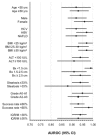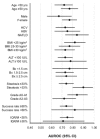Transient elastography for the noninvasive assessment of liver fibrosis: a multicentre Canadian study
- PMID: 21157581
- PMCID: PMC3004419
- DOI: 10.1155/2010/153986
Transient elastography for the noninvasive assessment of liver fibrosis: a multicentre Canadian study
Abstract
Background: Liver stiffness measurement (LSM) using transient elastography (TE) is a promising tool for the noninvasive assessment of hepatic fibrosis.
Objectives: To determine the feasibility and performance of TE in a North American cohort of patients with chronic liver disease.
Methods: LSMs were obtained using TE in 260 patients with chronic hepatitis B or C, or nonalcoholic fatty liver disease from four Canadian hepatology centres. The accuracy of TE compared with liver biopsy for the prediction of significant fibrosis (Metavir fibrosis score of F2 or greater), bridging fibrosis (Metavir fibrosis score of F3 or greater) and cirrhosis (Metavir fibrosis score of F4 ) was assessed using area under ROC curves (AUROCs), and compared with the aspartate aminotransferase-to-platelet ratio index. The influence of alanine aminotransferase (ALT) levels and other factors on liver stiffness was determined using linear regression analyses.
Results: failure of TE occurred in 2.7% of patients, while liver biopsies were inadequate for staging in 0.8%. Among the remaining 251 patients, the AUROCs of TE for Metavir fibrosis scores of F2 and F3 or greater, and F4 were 0.74 (95% CI 0.68 to 0.80), 0.89 (95% CI 0.84 to 0.94), and 0.94 (95% CI 0.90 to 0.97), respectively. LSM was more accurate than the aminotransferase-to-platelet ratio index for bridging fibrosis (AUROC 0.78) and cirrhosis (AUROC 0.88), but not significant fibrosis (AUROC 0.76). At a cut-off of 11.1 kPa, the sensitivity, specificity, and positive and negative predictive values for cirrhosis (prevalence 11%) were 96%, 81%, 39% and 99%, respectively. For significant fibrosis (prevalence 53%), a cut-off of 7.7 kPa was 68% sensitive and 69% specific, and had a positive predictive value of 70% and a negative predictive value of 65%. Liver stiffness was independently associated with ALT, body mass index and steatosis. The optimal LSM cut-offs for cirrhosis were 11.1 kPa and 11.5 kPa in patients with ALT levels lower than 100 U⁄L and 100 U⁄L or greater, respectively. For fibrosis scores of F2 or greater, these figures were 7.0 kPa and 8.6 kPa, respectively.
Conclusions: the major role of TE is the exclusion of bridging fibrosis and cirrhosis. However, TE cannot replace biopsy for the diagnosis of significant fibrosis. Because liver stiffness may be influenced by significant ALT elevation, body mass index and⁄or steatosis, tailored liver stiffness cut-offs may be necessary to account for these factors.
HISTORIQUE: La mesure de la rigidité hépatique (MRH) au moyen de l’élastographie transitoire (ÉT) est un outil prometteur pour l’évaluation non effractive de la fibrose hépatique.
OBJECTIFS: Déterminer la faisabilité et le rendement de l’ÉT au sein d’une cohorte nord-américaine de patients atteints d’une maladie hépatique chronique.
MÉTHODOLOGIE: Les chercheurs ont obtenu la MRH au moyen de l’ÉT chez 260 patients atteints d’une hépatite B ou C chronique ou d’une stéatose hépatique non alcoolique provenant de quatre centres d’hépatologie canadiens. Ils ont évalué la précision de l’ÉT par rapport à la biopsie hépatique pour prédire une fibrose importante (score de fibrose Metavir de F2 ou plus), une fibrose précirrhotique (score de fibrose Metavir de F3 ou plus) ou une cirrhose (score de fibrose Metavir de F4) au moyen de l’aire sous la courbe ROC (AUROC) et l’ont comparée à l’indice du ratio de l’aminotransférase par rapport aux plaquettes. Ils ont déterminé l’influence des taux d’alanine-aminotransférase (ALT) et d’autres facteurs sur la rigidité hépatique au moyen d’analyses de régression linéaire.
RÉSULTATS: L’ÉT n’a pas fonctionné chez 2,7 % des patients, tandis que les biopsies hépatiques ne convenaient pas pour établir la phase de fibrose dans 0,8 % des cas. Chez les 251 autres patients, l’AUROC d’ÉT pour les scores de fibrose Metavir de F2, F3 ou plus et F4 s’élevaient à 0,74 (95 % IC 0,68 à 0,80), 0,89 (95 % IC 0,84 à 0,94) et 0,94 (95 % IC 0,90 à 0,97), respectivement. La MRH était plus précise que l’indice du ratio entre l’aminotransférase et les plaquettes pour la fibrose précirrhotique (AUROC 0,78) et la cirrhose (AUROC 0,88), mais pas pour la fibrose non significative (AUROC 0,76). À un seuil de 11,1 kPa, la sensibilité, la spécificité et les valeurs prédictives positives et négatives de cirrhose (prévalence de 11 %) s’élevaient à 96 %, à 81 %, à 39 % et à 99 %, respectivement. En cas de fibrose importante (prévalence de 53 %), un seuil de 7,7 kPa était sensible à 68 % et spécifique en 69 % et avait une valeur prédictive positive de 70 % et une valeur prédictive négative de 65 %. La rigidité hépatique s’associait de manière indépendante à l’ALT, à l’indice de masse corporelle et à la stéatose. Les seuils de MRH optimaux de cirrhose étaient de 11,1 kPa et de 11,5 kPa chez les patients dont les taux d’ALT étaient inférieurs à 100 U/L et de 100 U/L ou plus, respectivement. Lorsque les indices de fibrose étaient de F2 ou plus, ces chiffres étaient de 7,0 kPa et de 8,6 kPa, respectivement.
CONCLUSIONS: Le principal rôle de l’ÉT consiste à exclure la fibrose précirrhotique et la cirrhose. Cependant, l’ÉT ne peut remplacer la biopsie pour diagnostiquer une fibrose importante parce que la rigidité hépatique peut être influencée par une élévation marquée de l’ALT, par l’indice de masse corporelle ou par la stéatose. Des seuils de rigidité hépatique personnalisés pourraient s’imposer pour tenir compte de ces facteurs.
Figures





References
-
- Friedman SL, Maher JJ, Bissell DM. Mechanisms and therapy of hepatic fibrosis: Report of the AASLD Single Topic Basic Research Conference. Hepatology. 2000;32:1403–8. - PubMed
-
- Rockey DC, Caldwell SH, Goodman ZD, Nelson RC, Smith AD. Liver biopsy. Hepatology. 2009;49:1017–44. - PubMed
-
- Myers RP, Fong A, Shaheen AA. Utilization rates, complications and costs of percutaneous liver biopsy: A population-based study including 4275 biopsies. Liver Int. 2008;28:705–12. - PubMed
-
- Regev A, Berho M, Jeffers LJ, et al. Sampling error and intraobserver variation in liver biopsy in patients with chronic HCV infection. Am J Gastroenterol. 2002;97:2614–8. - PubMed
Publication types
MeSH terms
Grants and funding
LinkOut - more resources
Full Text Sources
Medical
Molecular Biology Databases
Miscellaneous
